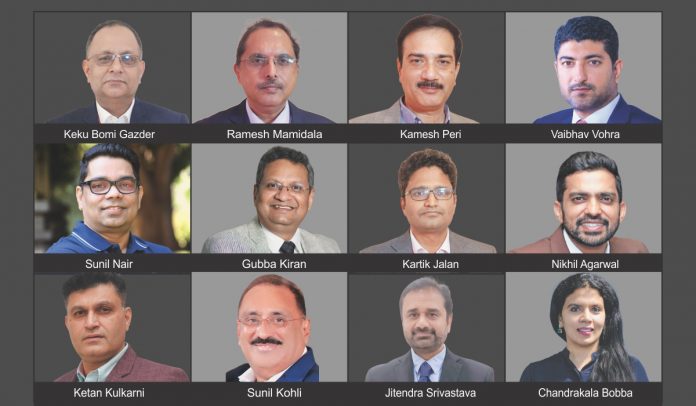Perishables and pharmaceutical deliveries are on the rise. Regardless of having world-class infra for movement of cold chain products, the sector is struggling with challenges impeding efficiency of supply chain ops, especially in interior areas. A lot needs to be done to facilitate intercity and interstate deliveries.
Ritika Arora Bhola
Be it Mahabaleshwar strawberries, apples from Kashmir, oranges from Nagpur and mangoes from Andhra Pradesh, there has been a surge in demand for intercity movement of fruits, vegetables, and pharma, because of a constant shift in consumer behaviour, preferences, increased internet penetration, and surge in e-commerce after the pandemic.
The increase in the movement has placed new demands on the perishable supply chain. Ensuring adequacy, safety, and resiliency of the supply chains has become critical. The challenge of minimizing wastage, especially in the Northeast, where thousands of tonnes of perishables are wasted every year, needs to be addressed. With perishable exports on the rise, one must examine how cargo movement is taking place at regional and major Indian airports to facilitate seamless trade and minimize wastage.
The state of cold chain infrastructure in India is promising but needs further development. Addressing perishable wastage requires increasing refrigerated transportation capacity and educating stakeholders. Optimizing cargo movement at domestic airports is critical to promote perishable exports. Challenges such as high operating costs, limited investments, a fragmented distribution approach, low compliance, expertise in handling perishables, and lack of multi-commodity/multi-temperature storage facilities and the absence of standardized practices continue to hinder the sector’s growth trajectory. In conclusion, ensuring adequacy, safety, and resiliency of these supply chains is vital to meet the increased demand for intercity food and pharma deliveries.food wastage down, packaging improves
The cold chain industry got its prominence during the pandemic. India came out right on top during distribution of COVID vaccines. We had the maximum number of vaccines delivered in perfect condition. I did not hear of any vaccines getting spoilt because of poor logistics. The industry provided maximum support as supply chain had to be maintained not just at the airports, but also in the first mile and the last-mile delivery.
It is an evolving mechanism of innovation that is required to see how one can keep that level of freshness in a continuous momentum until it gets to one’s stomach. To do that cold chain is the critical part, which includes everything and not just storage. Also, happy to know that perishables wastage is coming down because of innovations in packaging technology. The more we focus on these critical elements within the chain, more fresh is the food going to be. All airports do not have the same kind of processes. As long as the processes meet the requirements of the regulatory authorities, there should not be any problem. Because at the end of the day, two things matter. Are you in compliance of the rules and regulations—local and in other destinations. Having standardization will only help further, because the supply chain industry would then have certain benchmarks, certain levels that can be measured by various external agencies.
Future growth from tier II, III cities
Commendable infrastructure development is in place at major airports to facilitate seamless cargo movement. But in the next four-five years, the industry needs to focus on creating infra and world-class quality cold chain in tier II and III cities. The future export growth will come from these cities. Therefore, the industry needs to build the infrastructure that would include the belly capacity deployment from the airlines in tier II and III cities, the airport infrastructure, the regulatory-related infrastructure, in the next four-five years. I feel the agricultural wastage taking place in rhe Northeast is overestimated in India.
Connecting the Northeast with air cargo or airline capacity may not be sufficient to move products. Connectivity must come in the form of railway network as well as surface network, which is currently in progress. In the next couple of years when linkage is in place, we might see the Northeast feeding exotic fruits and veggies to the rest of the country. So, with better connectivity we might possibly see much better distribution from the Northeast.
Currently, we have a network capacity of half a million tonnes. We are planning to hike the same to two million tonnes by 2007-end. But if one were to look at the existing capacity of half a million tonnes, 350,000 tonnes are global capacity and 150-170,000 tonnes are domestic. If you look at the volume distribution of all products exported, in total exports, 22-23 per cent comprise perishables. In the domestic market that is a good 30-35 per cent. We do carry perishables in the domestic and the global market.
We will see more perishables being exported in near future mostly from tier II and III cities. In 4-5 years, we would expand our network by connecting to Middle Eastern Europe. In fact, we have flights out of Cochin, a perishable export centre, into Gatwick. We have a flight from Goa to Gatwick, and Ahmedabad to Gatwick.
Opportunities for perishable exports
There are several opportunities available, especially for perishable exporters. India produces a lot, but it is not able to export a lot in terms of the global market share. There have been incremental improvements by the different stakeholders, they are coming together and trying their bit. Ultimately, there is a lot that needs to be devised, especially when it comes to transportation, cold chain, packaging, interim storage before coming to the airports. From the farm to the plate, there are a lot of elements that need to be taken care of. The distances covered are quite significant because there are key airports where there are major capacities available for export. So, for someone who is in the hinterland, (tier II and III cities), for their produce to be picked up and then brought across to the airport, ferried to the destination, and delivered to the final consumer, several steps need to be covered.
Unfortunately, these various stages are not well taken care of. So, there is a lot of work that needs to be done in that area. We need to make sure that if we want to export vegetables and fruits in a manner that would give us a better position in the international export market, then we need to do many more things to make that happen.
Cold storages for avoiding wastage
To ensure the adequacy, and safety of food and medicine deliveries, there are a couple of measures that can be taken. The important factor to consider is the type of vehicle that can be used. Depending on the nature of the product, the mode of transportation needs to be chosen. For local delivery of perishables, reefer trucks and trailers, equipped with cooling systems, are commonly used. These help in maintaining the freshness of the perishables.
Another point to consider is maintaining temperature throughout the product’s transit cycle. Any variation can be detrimental to their quality and shelf life. In India, the cold chain infrastructure for transport of perishables is on a growth trajectory. However, when the scope of operations and efficiency are considered, there is space for improvement. One of the challenges in cold chain infrastructure is the reliance on smaller vehicles, which are less efficient, particularly while ferrying larger quantities of perishables. This inefficiency increases transportation costs and leads to delays and losses. India’s cold storage facilities are yet to become energy efficient, which results in wastage. This is a concern, more so in a country where perishables and pharma are in high demand.
Investments are required in energy-efficient technology and climate control systems to bring cold storage facilities up to global standards. Expanding cold chain infrastructure in rural and interior areas where perishables are produced, can reduce wastage, and enhance access to cold storage and transportation services. Reforms are critical; they simplify rules and provide incentives to attract private investments.
The cause of wastage is the lack of infra in remote locations. The Integrated Cold Chain & Value Addition Infrastructure Scheme seeks to create an integrated supply chain to reduce post-harvest losses. The Kisan Rath Smartphone App was launched to improve transportation by providing access to farm produce trucks. A subsidy plan for creating cold chain infra and initiatives such as NLP will enhance logistic infra and cut operating costs.
Enhancing Food & Pharma Deliveries
A key factor driving this surge in B2C deliveries is the progress made in cold chain packaging in the past few years. These advancements have revolutionized the way perishables are ferried over long distances without the need for refrigerated trucks. These solutions can uphold the desired temperatures, even in cases where deep freezing at -20°C is required for around 72 hours. These developments in cold chain packaging, have brought about many advantages for firms looking to meet the growing demand for intercity B2C deliveries in smaller quantities.
Developing infrastructure: India’s cold chain infrastructure for perishables may be evaluated from a technological and qualitative standpoint. In terms of technology and quality, India’s cold chain infra meets global standards. However, there is room for improvement. The country relies on smaller or reefer vehicles for transportation compared to China and the USA where they use huge trucks. While transporting large amounts of perishables, the smaller trucks are less efficient. Because of this inefficiency, transportation in India is expensive per kg.
Building cool & frosty supply chain: In India, vegetables are often priced low, with low production costs. This makes it economically unfeasible for anyone to send refrigerated trucks to farms far from consumption centres and ferry the same to the cities for consumption. When you compare the production with wastage and the cold chain costs, the latter is higher. Farmers, facing this reality, frequently choose not to use cold chains. This is the reason why cold chain infra is sparingly used in the interiors of the country. In urban areas, it is used for products such as Shimla apples, grapes, or imported fruits—the production cost is higher per kg. The situation changes when dealing with lower-cost items such as okra. In such cases, it is challenging for farmers to justify investing in a cold chain infra for a product with such low market value.
Cold chain infra in rural areas
The surge in demand for intercity food and medicine deliveries necessitates an approach to ensure the safety and resiliency of perishable supply chains. Adequacy refers to the ability of the supply chain to meet the demand efficiently. Safety entails maintaining the quality and integrity of perishables, and resiliency involves the ability to adapt to unforeseen challenges, such as disruptions in transportation or adverse weather conditions. To address these aspects, we implement strategies as follows:
- Quality control: We adhere to quality standards and conduct regular inspections to ensure perishables meet safety and freshness criteria. Advanced technologies such as IoT-enabled sensors and real-time monitoring play a pivotal role in this process.
- Temperature-controlled vehicles: These vehicles maintain the desired temperature range throughout the journey, safeguarding the quality of goods.
- Real-time tracking: These systems enable us to monitor the condition of perishables in transit. In case of deviations from the optimal conditions, corrective actions can be taken to prevent spoilage.
To enhance cold chain infra, PPPs play a vital role. Additionally, incentivizing businesses to invest in cold chain infra in underdeveloped regions can stimulate growth and reduce wastage. Educating farmers and producers about the best practices in post-harvest handling and transportation can also reduce wastage. Awareness campaigns promote the importance of proper packaging and storage techniques. Ensuring smooth cargo movement at regional and major Indian airports requires collaboration between various stakeholders. This includes authorities, airlines, and logistics partners. Streamlining customs processes and reducing bureaucratic red tape can expedite the movement of perishable exports.
Misconception with cold storage
There is a lot of misconception when it comes to cold storage in India. A lot of people often say that there is shortage of infrastructure for cold chain. I feel that there is a shortage of good, palletized, or automated infrastructure, but there is no shortage of cold chain infrastructure in India. Today building a new cold storage facility is a six-month decision. Just a couple of months ago, we got a facility made in 45 days. So, infrastructure is not the issue. It is about the consumers getting aware of what they eat and what they need. I think the pandemic has motivated all of us to consume hygienic and healthy food and be careful about what we are eating. And that has been instrumental I think in promotion of cold chain infrastructure in the country as well as in improving the services across the country.
I will give you a case example. Pineapples are grown in Arunachal Pradesh and other Northeastern states, but the same are not grown in Delhi or other areas. Fort that, you need rail infrastructure to export pineapples to Delhi and other states. Is rail infrastructure missing? Are the refrigerated vehicles missing? There are many people who have taken lot of subsidies from the government to make that infrastructure available to the farmers, but then why are the pineapples not exported?
I say when the consumer is ready to accept the rise in prices, if he or she is willing to shell out the extra amount, there is someone not providing you the service. Right now, India is perhaps one of the few countries in the world where drone pharma deliveries have started in remote areas. With all of this, we are seeing a lot of transformation happen. There will be gaps, but I think we are moving in the right direction.
Cold storages to preserve freshness
There has been a rise in demand for of perishables such as, frozen food, seasonal vegetable & fruits, and pharmaceuticals. These perishables require care to secure their optimum shelf life. Facilities such as cold storage vehicles, temperature-controlled vehicles, thermal blankets have become need of the hour.
Additionally, these storage facilities may need to meet the requirements such as cold rooms, dark rooms to preserve the freshness and quality of perishables. We have introduced customized containers for transportation to save space and increase efficiency. We own and hire fleets across India. To avoid wastage due to short shelf-life of products, the companies need to identify alternate modes of transport for faster deliveries. Supplementing the FSMEs sector, CJ DARCL works on airport to airport model and has the capability to work on door-to-airport, airport to door and door to door model, involving loading and unloading of the cargoes, counting, weighing, labelling, categorizing, and packaging.
Operating costs hinder growth
Blue Dart cargo planes and their multimodal TCL solution carry perishable shipments to consumers overnight to multiplexes (pin codes) across India with less dependence on cold storage and more reliance on Just-In-Time.
The government’s initiatives—approval of 27 integrated cold chain development projects under Pradhan Mantri Kisan SAMPADA Yojana in 2020, highlights the need to bolster this vital infra. Challenges such as high operating costs and absence of standardized practices continue to hinder its growth trajectory.
The Open Network and Digital Commerce innovation, with the infrastructure push, can create a national grid of expressways and rise in road infrastructure, remove impediments in surface mobility (similar to octroi) along with innovations in packaging (from single use to multi-use, in data loggers (from passive to real-time data loggers), in reefer trucks (from single truck to partitioned trucks) is helping the express industry add its speed to the cold chain infrastructure.
To ensure zero wastage of perishables, constant temperatures need to be maintained throughout the supply chain—from origin to destination. Investment in world-class infra and transportation facilities, including reefer vehicles, by cold chain service providers, airports, and airlines, would strengthen the supply chain.
To address these challenges, there has been a surge in infra development. This includes rapid infrastructure growth, increased digitalisation, and focus on sustainable logistics. Initiatives such as ‘Make in India’ and the ULIP have enhanced transparency in the logistics sector. Digitization of work processes, paperless document processing, and shipment tracking have increased the speed of goods movement, while reducing logistics costs. Also, infra development, including expansion of India’s road network and the DFC project, is also progressing. For a 33 per cent rise in infrastructure development, the Union Budget for 2023-24 has allocated Rs 10,000 crore for urban transport, and commissioning 50 new airports to improve connectivity.
It also includes the highest ever railway outlay of Rs 2.40 lakh crore, along with proposed PPPs for coastal shipping and transportation, thus addressing the requirements of a rapidly growing economy.
Temp-control facilities at airports
An honest observation of the present cold chain infrastructure for tranporting perishables in the country reveals measures are yet to be taken to turn the tide into a satisfactory resolution. The supply chains for vegetables and pharmaceuticals lack ripening rooms, inadequate cold storage, and other facilities. The non-availability of reefer vehicles and absence of support for seamless road transportation further add to exporters’ woes.
The existing facilities available for pharma shipments have plenty of room for improvement. Hence, logistics coupled with processing of goods at various airports needs to be looked at by handling agencies with care. The industry expects a growth in pharma movement in the future. All airport hubs should be equipped with cooling/temp control provisions as temperature plays a vital role in preserving pharma’s longevity.
The export of perishables has been increasing from major Indian ports. The pace is yet to pick up from the regional stations for lack of required infra support. It is observed many exporters from smaller regions prefer to bring their goods to the main export station instead of initiating the required process at their ends.
Such practices are likely to continue until the desired facilities to achieve seamless functions are made available at regional stations. The government and other stakeholders may like to consider it. As regards zero wastage, an efficient cold chain management helps minimize food waste and losses as it can reduce spoilage, damage, and product expiration by maintaining optimal temperature control, implementing efficient handling and transportation practices, and optimizing inventory management. This minimizes financial losses and reduces food wastage.
More reefer vehicles, freighters needed
We respond to the increasing demand for intercity food and medicine deliveries with a commitment to cold supply chain excellence. We harness cutting-edge technology and logistics solutions-for crafting efficient routes to guarantee timely, secure, and precise deliveries supported by our partnerships with suppliers and network partners. India’s cold chain infrastructure for perishable transportation is on an upward trend.
The Southern and Western states shine with well-developed cold chain networks, while the Eastern and Northeastern regions still await development. It is a must to bridge this divide and unlock the country’s potential in ensuring safe and efficient perishable transportation. The challenge is serious, driven by insufficient cold chain facilities, inadequate road, and rail infrastructure, and creating awareness among farmers, traders, and consumers.
Both the public and private sectors are working together to tackle these issues, but there is no denying the fact that there is much ground to cover. While awareness and increasing costs persist, collaboration between the public and private sectors hold promise of changing India into a major perishables exporter in the years ahead.
Focus on FMCG industry
Last-mile delivery of perishables and medicine is a challenge. Adoption of technologies such as deep freeze wraps, insulated carriers, and shared pick-up reefer trucks for city and intercity travel along with real-time loggers with IoT connectivity is the solution to ensure safety and resiliency of perishable supply chains.
Cold chain and reefer infrastructure are a deficit for perishables and medicine movement and storage. Micro warehouses (temperature-controlled) in urban and rural districts are key drivers that can help meet this deficit. According to industry reports, cold chain infrastructure can be developed more in the coming years. Perishable wastage and spoilage of biological character are higher in our country, though enough awareness has been created by the concerned departments and industry stakeholders. Cold chain facilities are expensive and difficult to establish in interior places in the Northeast, despite government subsides. The focus is still on the fast moving consumer goods (FMCG) industry and not on fuits and vegetables in the country. Also, freighter capacities and cold transportation in India are not yet popular in such zones.















